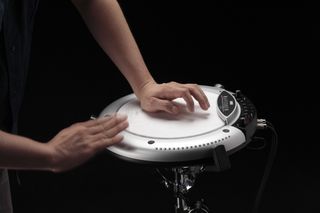Introducing the new Wavedrum Dynamic Percussion Synthesizer from Korg.

The original Wavedrum, released in 1994 is, one of Korg´s legendary musical instruments famous for its innovative design, performance possibilities and unique sounds. This next generation is a more affordable version, plus it's sonically richer, more sensitive, more powerful and expressive.
The Wavedrum has a wide variety of instruments on-board ranging from standard acoustic percussion instruments to new and unique percussion sounds. Instruments that normally require special techniques to play, such as tabla, conga, etc. can be played easily. With its compact and light weight design, the Wavedrum will fit all performance situations from casual playing through to full on recording or performance.
The user can change the pitch randomly with each hit, or play melodic phrases by setting a musical scale and applying pressure to the head, a performance characteristic unique to the Wavedrum. You can get new previously impossible sound variations such as controlling the pitch or tone of the release part of a sound by pressing the head after playing it by hand or mallet. You can sustain sounds just by pressing the head. So, for example, the Wavedrum can produce sitar and tanpura sounds at the same time.
A percussion instrument that produces dynamic sounds by strokes of the hand is a very naturally physical instrument. The Wavedrum, although an electronic musical instrument, sticks to this physical concept. The head and rim pickups are directly used as a sound source to be processed by the DSP (Digital Signal Processor) algorithms and trigger the PCM sound engine.
Together with the pressure sensor under the head, the Wavedrum responds to subtle motions of fingers and hands such as hitting, rubbing, scratching etc. as well as to traditional hand playing techniques such as open shot, slap shot, heel and toe, mute, etc. The rim features two types of notches, small and large, and these can be used to get a tremolo type effect by scratching with sticks, etc. Combine the rim sounds with head sounds for an even richer, more original performance.
The Wavedrum contains 36 software based algorithms that use DSP technology to realise a variety of synthesis methods such as analog, additive, non-linear, physical modeling, etc. Working with these algorithms, you can create various instrument sounds, natural sounds, etc. in addition to the Wavedrum's own unique sounds. The PCM sound engine, the other important part of Wavedrum´s sound creating system, contains 200 PCM sounds - 100 for the head and 100 for the rim. Combining the PCM sounds with the algorithms delivers a natural response which is not possible with ordinary PCM only sound systems.

There are a range of parameters available for editing sounds (based on the preset programs) to suit your own music or style of playing. In addition to making changes to pitch, decay time, loudness, reverb, delay, and curve (intensity) of the pressure sensor, etc., you can completely alter the sound by, for example, changing the head from skin to metal. The combination of algorithm and PCM sounds can also be changed to create totally new sounds from scratch. These new programs (up to 100) can be stored in the user area. The Wavedrum also has a Live Mode which can store up to 12 favourite programs (from preset or user programs) for selecting programs instantaneously during stage performance.
You can enjoy the Wavedrum just by playing the sounds alone, or you can use the jam function to experience the fun of a jam session. The Wavedrum contains 100 loop phrases from various musical genres and tempos. Also, there is an AUX input so you can mix the Wavedrum with an external audio source such another Wavedrum, a CD/MP3 player or other audio source.
The Wavedrum will be available in December and will cost £459 inc VAT

